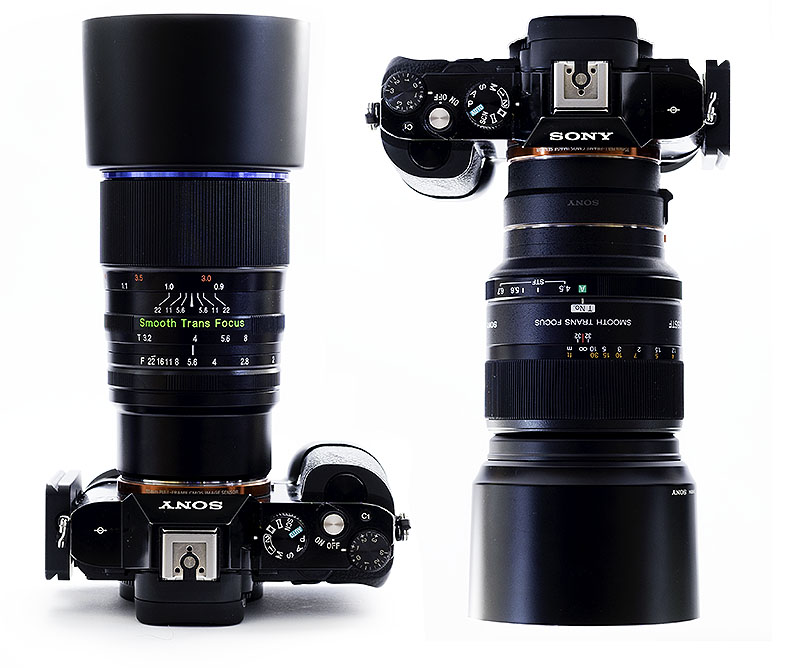
There is only a hand full of lenses which incorporate an apodization element which improves bokeh at the cost of light transmission. Today I will compare two of them. The Sony STF 2.8/135 was released 1999 by Minolta and is known for it’s uniquely smooth bokeh. The Laowa STF 2/105 is a new lens released this year by Chinese newcomer Venus Optics. In this post I will see where their strengths and weaknesses lie.
Disclosure
The Laowa STF 2/105 was loaned to my by the manufacturer Venus Optics free of charge for about three weeks.
The Sony STF 2.8/135 is borrowed from co-author Yannik, thanks for that!
Specifications
| Sony STF 2.8/135 | Laowa STF 2/105 | |
| Weight | 730 g + Adapter | 745g (probably the weight of the EF version, my scale is broken) |
| Dimensions (LxD) | 99 mm x80mm | 98 mm x 76 mm |
| Number of aperture blades | 9 | 13 |
| Close focusing distance (maximal reproduction ratio) | 87 cm (0.25) | 90 cm (0.15) |
| Elements/Groups | 8/6 | 11/8 |
| Price | $1398 new | ~$900 used | $699 new |
The Method
- Unless mentioned images are raw files from the Sony a7 converted in LR with the default settings.
- Unless mentioned I used a tripod and a 2 seconds timer.
- To view the images in full resolution check out this flickr set.
- I have tried to keep the reproduction ratio for the subject the same but I wasn’t too careful with the framing.
The Images
Bokeh
While both lenses show pleasing bokeh there isn’t much of a similarity between the two.
The Sony STF 2.8/135 displays it’s very unique bokeh, out of focus highlights blend into the background super smoothly, as if you had applied a gaussian blur filter in photoshop. It should also be remarked that the Sony STF has almost zero vignetting and therefore we don’t see any cat-eye-effect.
The Laowa 2/105 has much more conventional bokeh. There is notoutlining effect and compared to most other lenses I would say that it has really good bokeh but the transition from highlights to normal background simply isn’t nearly as smooth as with the Sony. It also shows significant vignetting which causes the cat- eye-effect.
Axial CA
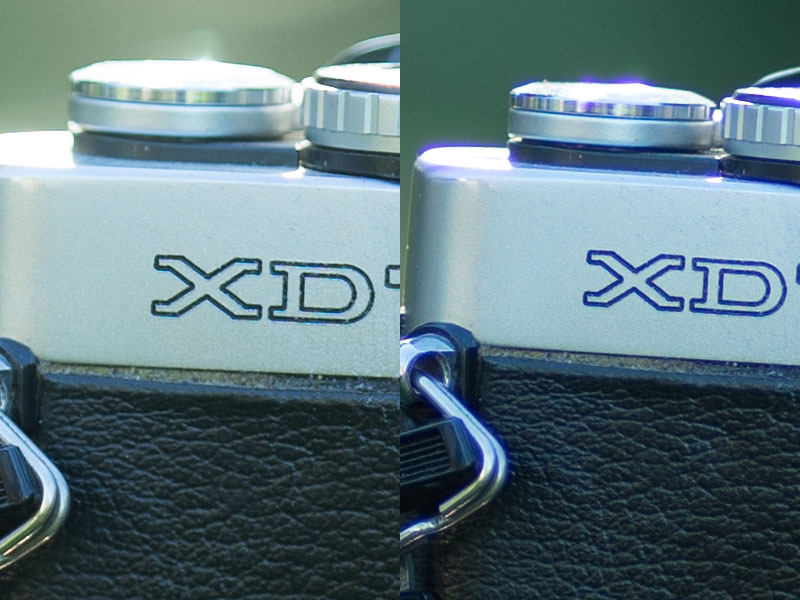
The Laowa turns in an truly exceptional performance here, only very few lenses could compete with it and those are a lot more expensive.
The Sony isn’t bad by the standard of most other lenses but it can’t hold a candle to the Laowa’s performance.
Contrast
The Laowa has a real issue with veiling flare. Even in this scenario where there is no direct light source in the image this causes some contrast loss and the blacks turn a little brownish. I haven’t had any issues in this regard with the Sony so far but I haven’t tested this aspect in depth.
Apart from the much warmer rendering of the Laowa this image lets us compare the bokeh in transition zone:

While the Laowa shows somewhat nervous bokeh in the transition zone the Sony performs absolutely superb here.
I didn’t change the tripod position for this image but none of the less it shows that the foreground bokeh is in both cases a little weaker than the background bokeh. It also shows again that the Laowa has some vignetting while the Sony has none.
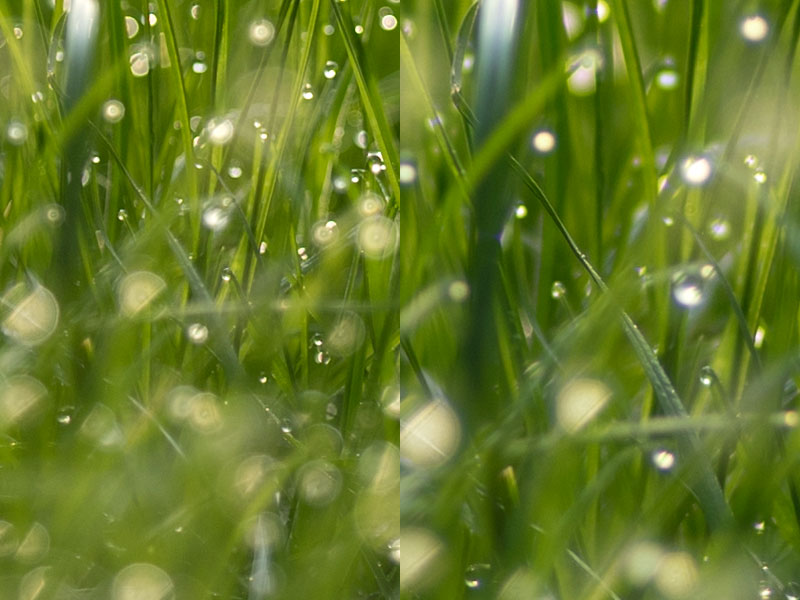
Both images were taken at the respective close focusing distances of each lens. You see that the Laowa has an average reproduction ratio of about 1:7 while the Sony allows you to get quite close with a reproduction ratio of 1:4.
Sharpness
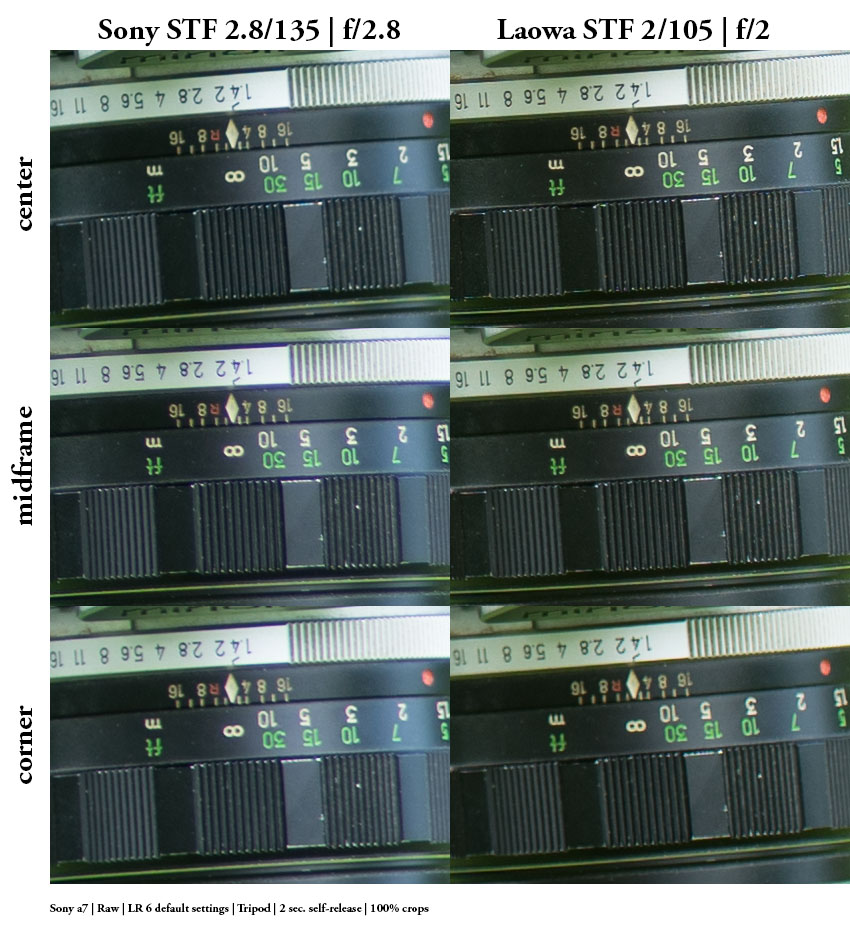
Tested wide open at portrait distance both lenses are very sharp, the Laowa might have the edge but both lenses deliver a very good performance and you won’t ever have to worry about sharpness.
More Images
I have analyzed the important aspects in the images before but here are a few more images to get a more rounded impression of the lenses .
The following images are processed with my usual methods. Again they can be found in full resolution in this flickr set.
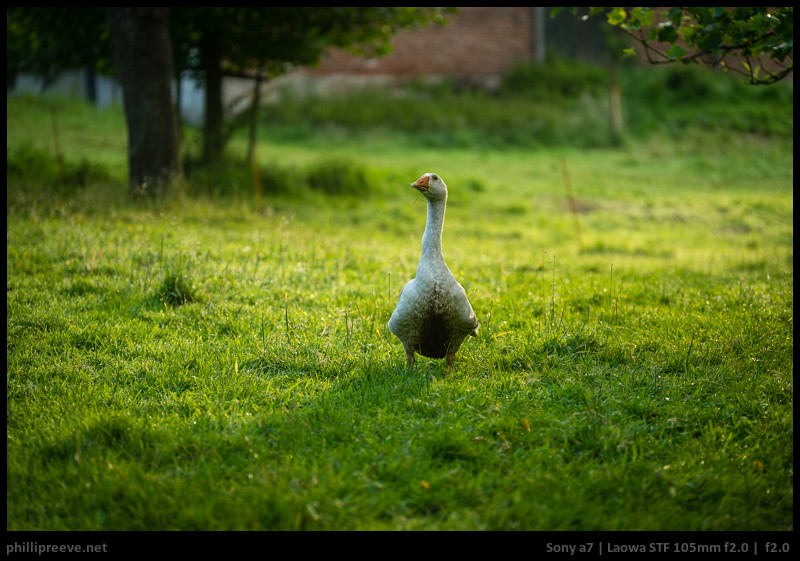
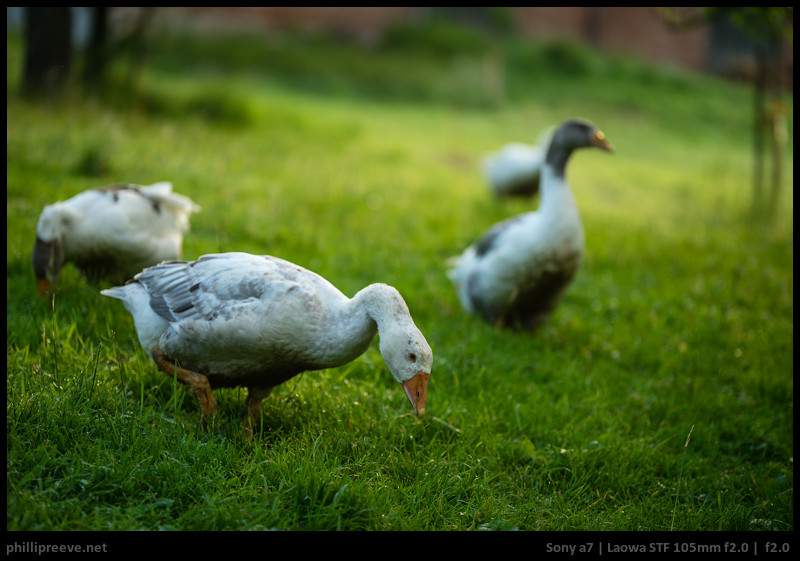
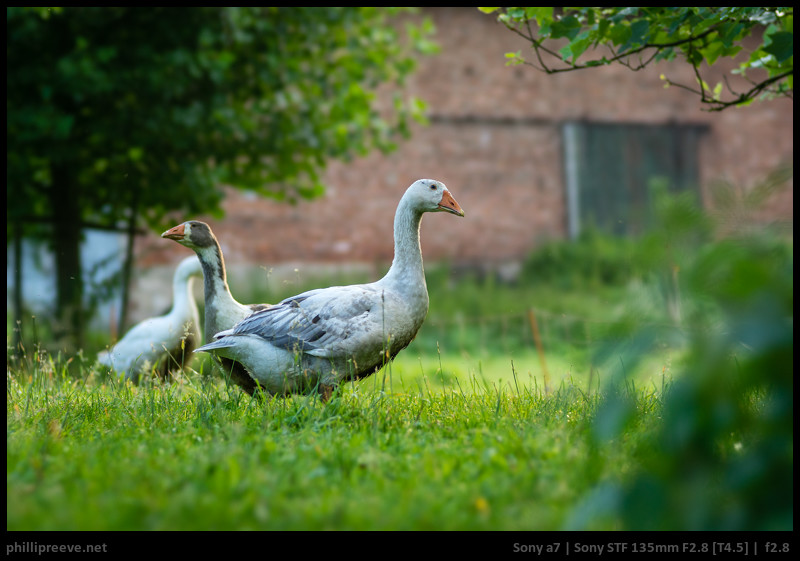
Handling
Both lenses are of similar weight and size so no advantage for either one.
The Laowa is very pleasant to handle, the focusing ring is quite smooth and it does not extend when it is focused. It also feels very solid because it is completely made from metal.
The Sony’s handling is okay but less pleasant than the Laowa, the focusing ring isn’t very smooth, I found it sometimes hard to nail the focus and it extends nearly 4cm when it is focused at the closest distance. Since it is partly from plastics it doesn’t feel as nice as the Laowa but it doesn’t feel cheap either.
When you use the Sony LA-EA3 or LA-EA4 you can control the aperture of the Sony STF 2.8/135 with the camera and lens and aperture will be recorded in the exif file.
Conclusion
So the conclusion is that both lenses are exceptional in one aspect and that’s the degree of CA correction for the Laowa and the bokeh for the Sony.
Both lenses are super sharp and among the sharpest lenses you can buy in their focal length, you should never need to worry about sharpness. You also lose about 1.5 stops of light with both lenses which is more of and issue with the Sony because it is only semi fast to begin with.
The Laowa has still very good bokeh by any standard but bokeh will look much the same if you use a lens like the Zeiss Makro Planar 2/100 or Olympus 2/100. Unlike those lenses the Laowa has almost zero axial CA but the competitors don’t loose a stop of light to the apodization element and they are far more flare resistant which can be a real issue with the Laowa. The handling of the Laowa is quite good and it feels very solid. I think the price of the Laowa is just right.
The Sony has truly unique bokeh and no competition in this aspect. I can’t say that I always like the effect, it works well for some scenarios but often I prefer to have some structure in the background and the Sony excels at eliminating any structure from it. I think the handling of the Sony STF 2.8/135 is good enough but at this price point I would have expected a little more premium feel and a nicer focusing ring. The very short minimal focusing distance and the exif information are a bonus for the Sony.
So which lens should you buy? That depends a lot on what you are looking for. Both lenses are specialist lenses which do some things really well but they also have their limitations.
If you feel you could have use for a semi-affordable, very sharp lens with excellent CA correction and good bokeh the Laowa might be a good option for you.
If you want the smoothest bokeh money can buy the Sony is just your lens but you have to be wlling to pay quite a lot for that and be willing to make some smaller compromises when it comes to build quality and handling.
The Laowa STF 2/105mm currently (July 2016) sells new for $699 at ebay.com (affilate link).
The Sony can be bought new at amazon.com for $1398 or used for about $900 at ebay.com (affiliate links).
If this review was helpful to you, please consider using one of my affiliate links. I will earn a small commission on your purchase and it won’t cost you anything. Thanks!
Further reading
- Comparison: $20 Minolta MC 1.7/55 vs $1000 Zeiss 1.8/55
- Manual lenses on the Sony a7 – A beginners guide
- Affordable manual lenses for the Sony Alpha 7,7r,7ii,7rii and 7s
- List of all our reviews
This site contains affiliate links. If you make a purchase using any of the links marked as affiliate links, I may receive a small commission at no additional cost to you. This helps support the creation of future content.
Latest posts by Phillip Reeve (see all)
- Review: Samyang AF 75/1.8 FE - April 12, 2021
- The FE-List now has 113 lenses on it - March 25, 2021
- 2020 – Year’s end review - December 28, 2020
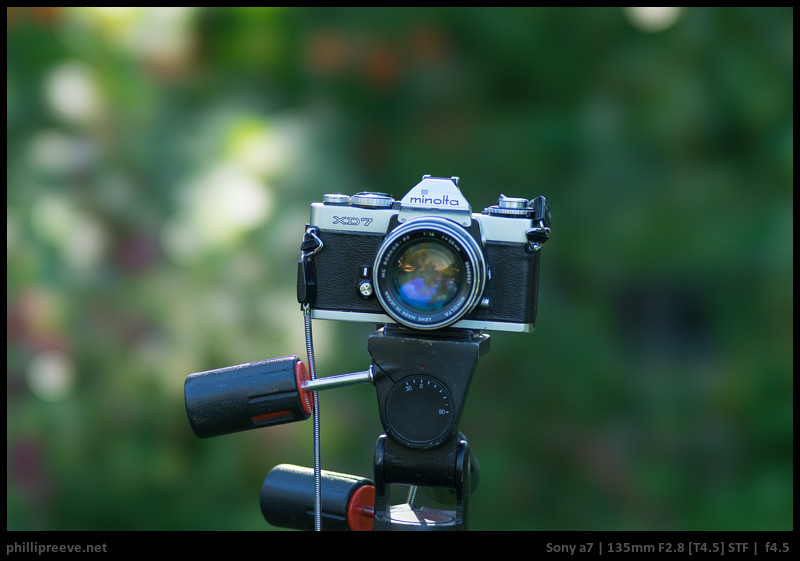






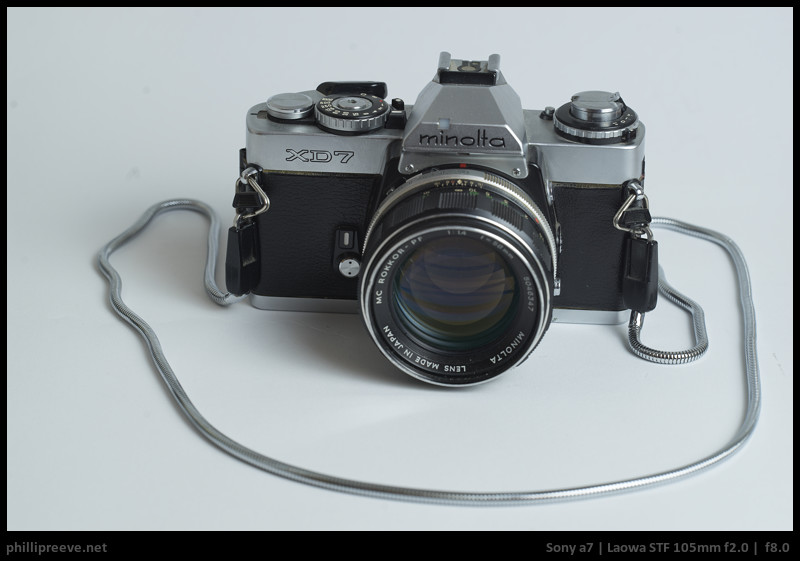
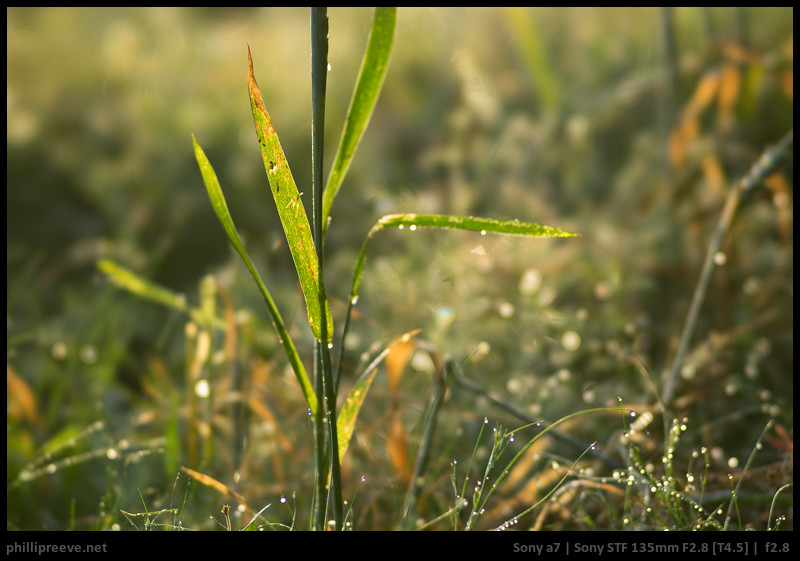



Hello, very nice review. How do you rate the Walimex 135 f2 in comparison?
I have it and love its sharpness and nice handling. Bokeh is a different story and often a subject of distance to the main subject in the image.
I think the Samyang is quite similar to the Laowa in that it has great CA correction but the Laowa is built nicer. Sharpness will be on a similar very high level.
Not worth it, imo. Laowa has really, really nice CA protection, but it’s bokeh is pretty awful. If that’s the goal of the lens it’s not really cutting it for me.
Sony has nice bokeh but it’s really not anything fantastic (imo). Get a Minolta 58mm f/1.2 for $500 less.
At 135mm, most lenses should have pretty good bokeh anyways. How about the Tair 11a, which is a 135mm f/2.8 with 20 aperture blades? Test conditions are different, but its samples look almost as good as the Sony.
Sorry but I disagree completely. The Laowa looks only bad by comparison, compared to about any other 100mm lens it has very good bokeh. The Minolta MC 1.2/58 is much less smooth.
The number of aperture blades is irrelevant wide open where I tested the lenses and I am certain that it has quite different bokeh.
That makes ZERO sense. The Minolta bokeh is nowhere as smooth as the laowa much less the Sony.
I agree, there are a lot legacy lenses with a large number of aperture blades who don’t support a nice bokeh – a Jupiter 37A here is such an example.
By the way the control of the aperture blades of the Sony 135mm STF operates in two ways: manually (between T4.5 and T6.7) it uses the 10 blades where a camera-controlled setting uses the 9 blades. With open aperture it has no bearing on the result of course.
very helpful review. thank you.
Is there a reason you keep flipping what image is on the left/right of the variable image view windows?
Sometimes you label the 105mm on the left and the 135mm on the right, in other cases it’s the other way around. I assume that the image with the wider FOV is the 105mm, but sometimes you’ve labeled it as the 135mm. So what’s what?
1st image: (combo image) Left labeled as 135 (with wider FOV), right labeled 105
2nd image: (cropped image) Left labeled as 105, Right labeled as 135
3rd image: (combo image) Left labeled as 105 (with wider FOV), right labeled as 135
4th image: (cropped image) Left labeled as 105, Right labeled as 135
5th image: (combo image) Left labeled as 105 (with wider FOV), right labeled as 135
6th image: (cropped image) Left labeled as 105, Right labeled as 135
7th image: (combo image) Left labeled as 105 (with wider FOV), right labeled as 135
8th image: (sharpness) Left labeled as 135, Right labeled as 105
9th image: (combo image) Left labeled as 105 (with wider FOV), right labeled as 135
10th image: (combo image) Left labeled as 135 (with wider FOV), right labeled 105
So are the labels correct and you’re flipping what side the image is on … or are the labels wrong?
While in most cases I assume the 105 has the wider FOV and the labels are wrong… in the case of the sharpness examples… I can’t be sure what’s really what lens is what.
You see the exif data on each frame in the lower right? Those are correct and there was on instance were the Sony came first, in every other case the Laowa was first. Now it is always Sony first. As mentioned I tried to keep reproduction ration the same.
Thanks for replying! I didn’t want to make a judgment call on which lens I should buy until I was sure i knew what images came from what lens. 🙂
I’m not sure I’d agree that the close focusing of the Sony is a plus — it’s only 3cm closer (out of 90cm). I would think you’d need to see closest focus of each lens side by side to notice a difference, and half of that difference is due to the extra 30mm of zoom.
I think the difference in reproduction ratio (0.25 vs 0.15) is significant.
Hi. Can the Sony 135mm stf be used on a fuji body with an adapter (Sony Minolta a to fuji x)?? How would aperture work and can it just be used wide open? You say it’s best wide open anyway so im considering options as the bokeh is superb. Hope you can help.Thanks Dean
I have zero experience with the Fuji system and available adapters, sorry.
Dean Lewis, the Sony 135mm STF works perfectly with the Fujifilm X-H1 with a cheap Fotodiox adapter having a cropped view like a 200mm.
I am planning to buy sony stf and mount on Sony a7. Which adapter would work best for it?
La-EA3